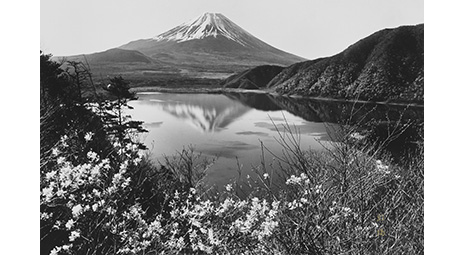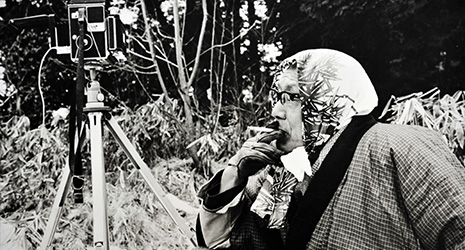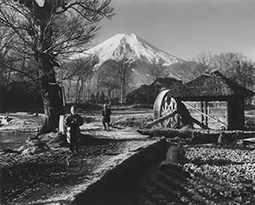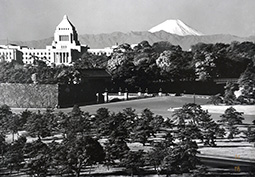January 2023
- English
- 日本語
A Pioneering Photographer of Mt. Fuji

Kohan no Haru (“Spring by the Lake”) (1935) 
Okada Koyo with camera and tripod wearing his padded kimono and a hand towel wrapped around his head

Mt. Fuji and Oshino Village (1930) 
Mt. Fuji on a snowy morning (1954) 
Mt. Fuji and the National Diet Building (1949)

Okada Koyo (1895–1972) is known as a photographer who dedicated his life to photographing Mt. Fuji and for establishing the Mt. Fuji genre of photography. His photographs appear on Japan’s banknotes and stamps and have become iconic images of Mt. Fuji for Japanese people.

On the reverse side of the 1,000 yen banknote currently in circulation in Japan there is a picture of Mt. Fuji viewed over cherry blossoms and a lake in which the mountain is reflected. Mt. Fuji’s reflection, visible on the lakes surrounding the mountain, is known as “Upside Down Fuji” and is a scene that has been loved by Japanese people since long ago. The image on the 1,000 yen banknote was based on Kohan no Haru (“Spring by the Lake”), a photograph taken by Okada Koyo (real name, Okada Kenjiro) at Lake Motosu (see here), one of the “Fuji Five Lakes” (Fujigoko) in Yamanashi Prefecture. Okada is known as a pioneering “Mt. Fuji photographer” who focused mainly on the mountain.

Okada was born in Niigata Prefecture, far away from Mt. Fuji. When he was 21, he visited Oshino Village in the foothills of Mt. Fuji in Yamanashi Prefecture. Fascinated by the views of Mt. Fuji that he saw there, he continued to photograph the mountain throughout his life. It is said that he once climbed Mt. Fuji in winter to take some photos, but slipped and was about to fall and narrowly escaped death. In his later years, he built a villa in Oshino Village. In 2004, some 30 years after his death, the Koyo Okada Photo Art Museum was opened nearby. Kakinaka Emiko, the curator of the museum, says that “there are between 380,000 and 400,000 photos of Mt. Fuji taken by Okada. In addition to the photo used for the 1,000 yen banknote, some 23 have appeared on Japanese stamps, and these have become established as iconic images of Mt. Fuji for many Japanese people. The photos of Mt. Fuji viewed over the thatched farmers’ houses of Oshino Village in particular are scenes that evoke a sense of nostalgia for rural hometowns among Japanese people.”

Okada called Mt. Fuji “Fujiko-san,”* describing the mountain as a hard-to-please lover, beautiful yet fickle. He said that no matter how many years he photographed the mountain, he could never capture the mountain as he envisioned it, and so he never stopped. Some local villagers remember seeing Okada head out to take photos wearing a padded kimono and a hand towel wrapped around his head, saying, “I’m off to see Fujiko-san.”
Okada donated some of the photos he took of Mt. Fuji to the three astronauts of the Apollo 11 mission which was the first to land humans on the Moon, as well as to General Douglas MacArthur, Supreme Commander for the Allied Powers in Japan after World War II. Okada also held an exhibition with Japanese photographers at the Baltimore Museum of Art in Maryland, the United States, working to introduce his photos of Mt. Fuji abroad.

Today, there is an observation deck on the northwestern shore of Lake Motosu where Okada photographed Kohan no Haru. Even today, many people continue to photograph the same scene from the place where Okada originally photographed it.
- * At the time in Japan, it was typical for female given names to end with “ko.”

